Remembering the ‘Saurian Monster’ That Terrorized 1880s New Zealand
How hysteria bred a mystery.

It must have been a ghoulish sight. At the slaughter yards of Frankton Junction, near Hamilton, New Zealand, in October 1886, workers found a sheep picked clean to the bones. Some creature, they reported, had taken the carcass from the hook where it hung, eaten its flesh, and then departed, leaving only a strange trail of footprints unlike any other they had seen. Men gathered their guns and revolvers and kept watch for its return.
These, New Zealand’s Daily Telegraph reported, were the “undoubted traces of a saurian monster.” The word “saurian” means lizard-like—other papers concluded that this monster must be an alligator or crocodile, despite New Zealand’s smattering of living reptiles being, without exception, only a few inches long.
For two months, throughout October and November, the people of the Waikato region kept up a near-constant watch for their worrying new neighbor. Farmboys reported seeing it in the river, with its head poking up from the creek; indigenous Maori told settlers that they had known of it for some time and called it a taniwha. “Stories are extant among them of a very large animal, like an eel, which has come out of the water at times and chased them, even seizing their legs in its teeth,” reported the New Zealand Herald. A year earlier, a Maori girl had allegedly been found dead in the same river, with the flesh stripped from her arm.
Gradually, a picture of the creature began to emerge—not an alligator, but something still more fearsome. Two men crossing the Waikato river in canoes were almost capsized by the creature, which chased them all the way to the shore. They described it as “of immense size with large jaws showing jagged teeth. The body was covered with long shaggy black hair.”
Then, a breakthrough. In Raglan, on the coast, the monster was found napping on the beach, captured, and shot twice in the head. “It is 12 feet long, and 6 feet in girth, with two large screw-like propellers in lieu of a tail,” the papers reported. “Its head is like that of a leopard, with two rows of formidable teeth, 12 in each row.” Its skin was silver, and its stomach found to be full of the bodies of birds.
An enterprising settler had plans for this beast. He bought the carcass and intended to exhibit it across the world, taking it first through New Zealand and Australia, and then all the way to the United States and Europe. But his grand plans were scuppered when the beast was finally unmasked, on November 26.
The United Press Association published their big reveal with the headline: “The ‘Saurian Monster’ Proves To Be A Grey Seal.” It’s unlikely this was an actual grey seal, since they don’t live in New Zealand, but rather a seal who was gray. That leopard-like head not so inexplicable after all—though one wonders which one of the many hundreds of thousands of New Zealand fur seals was, as they wrote, “believed to be still at large.”










Follow us on Twitter to get the latest on the world's hidden wonders.
Like us on Facebook to get the latest on the world's hidden wonders.
Follow us on Twitter Like us on Facebook